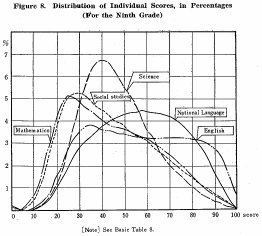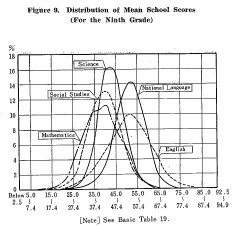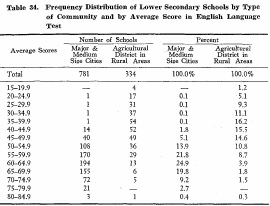| Home > Policy > White Paper, Notice, Announcement > White Paper > EDUCATIONAL STANDARDS IN JAPAN 1965 > CHAPTER |
||
Scholastic achievement varies to a considerable extent among individual pupils. Table 32 shows the national average scores achieved. As presented by frequency distribution of the scores of individual participants from the third grade of lower secondary schools, the score for each subject varies between 0 and 100 points. The extent of disparity is different with each subject tested. The greatest variation in individual scores was observed in the English language test in lower secondary schools.

Scholastic achievement varies to some extent among schools just as it does among individual pupils, resulting from variable local conditions in individual schools. Observing the frequency distribution of the average scores of school for each subject, it may be found that the highest average score is 70 to 80 points higher than the lowest.
Factors which influence variable levels of scholastic achievement maybe classified as social and cultural environmental community factors, and educational factors of the individual schools.

Table 33 shows the average pupil scores in schools located in the different types of communities. Average pupil scores were uniformly and significantly highest in residential areas of large urban communities, and lowest in remote rural areas.


The foregoing shows graphically the disparity between average scores of schools in urban and rural areas. It also shows that some schools in rural areas achieved relatively low average scores, while some schools in urban areas achieved relatively high scores.
Such disparities between average scores of schools in the same type of community probably are due to variable factors in the educational environment.
| Back to Top | MEXT HOME |